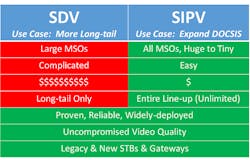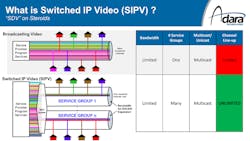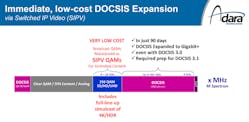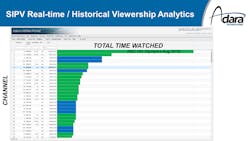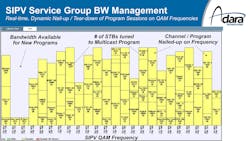High-speed internet is now an operator's most important service and, with so many streaming video services, keeping up with competitive internet speeds and capacities can be challenging. This task is particularly challenging when the RF spectrum is nearly full, occupied mostly by lower-profit video services that can easily consume upwards of 80% or more of the operator's precious RF bandwidth.
Switched IP video (SIPV), unlike all other technologies such as MPEG-2 to MPEG-4 conversions, HFC plant upgrades, and DTA deployments employed for DOCSIS expansion, enables operators to quickly and inexpensively free as many as 50 or more video QAM (or EIA) channels, making them available in as little as 90 days for DOCSIS 3.0, 3.1 and Full Duplex expansion (Figure 1).
What is SIPV?
SIPV delivers tremendous bandwidth efficiency by making programs available within a network service group only in response to subscriber channel requests. In addition, using only 12-24 QAMs or fewer, SIPV delivers an unlimited video channel offering of SD, HD and UHD/4K programming.
SIPV derives from proven, widely deployed switched digital video (SDV) technology. It follows that these technologies have similarities – but also important differences that stem from the very different use cases for which they are intended, as summarized in the table below.
It is also important to note that, like SDV, SIPV leverages multicast, so it does not "blow up" like unicast internet streaming does when everyone tunes in to watch the Super Bowl, for example.
Other features of SIPV include:
- SIPV consumes none of an operator's valuable DOCSIS bandwidth.
- SIPV deploys in as little as 90 days, not many months or even years like SDV.
- SIPV delivers powerful viewership analytics, so when a programmer is not negotiating fairly, operators have real-time knowledge from their systems to make the best business decisions.
- SIPV's only requirements relative to set-top-box (STB) compatibility are two-way functionality and an embedded SDV software client. Consequently, SIPV works with virtually all deployed legacy STBs as well as the newest STBs and gateways.
- SIPV facilitates the introduction of new UHD/4K channels. The UHD/4K channels are simply added to SIPV's unlimited channel lineup (even as a 4K simulcast of an existing MPEG-2/4 lineup) and 4K-capable STBs are then target-deployed only to subs who want the 4K services. As a result, the deployment of 4K/HDR becomes success-based and affordable, does not require the typical forklifting of legacy STBs and doesn't consume any DOCSIS bandwidth.
The "secret sauce" resides in SIPV's back-office utilities. For example, these utilities manage and monitor the QAM bandwidth utilization in as many as thousands of service groups simultaneously so that operators receive alerts when aggregate bandwidth in a particular service group starts to peak above 80%. Such proactive and simultaneous service group monitoring and alerts delivered in real-time enable the operator to plan ahead to split service groups, thereby managing the growth and evolution of the video network. The operator therefore can ensure that all video services are always available to all subscribers in every corner of the network.
How SIPV Works
SIPV deployment begins with dividing the digital video network from a single large service group into smaller service groups, typically between 500 and 1000 STBs each (Figure 2). These service groups can coincide with those already being used for VOD (if deployed). Each service group typically contains 4 to 8 nodes, depending upon node size and digital video penetration.
Next, a portion of the RF/QAM frequencies (typically 8 to 24, for example) currently used to broadcast all linear channels to all subscribers in all corners of the network are repurposed as "SIPV RF/QAM frequencies" (Figure 3) Physical universal edge-QAMs are separately deployed for each frequency in each service group. Each of the 8 to 24 SIPV QAM frequencies represents independent bandwidth for each service group; this permits the SIPV control system to nail up or tear down linear channels dynamically in response to at least one or more STBs in that specific service group being tuned to that channel.
The linear video programming itself remains in multicast format but, if not already, it is encapsulated into Internet Protocol (IP) format. Further, the programming is converted from its typical multi-program transport stream (MPTS) format into single program transport stream (SPTS) format so that the SIPV system can access individual program streams and can nail up and tear down these individual streams, as required, on specific edge-QAMs and frequencies in each service group.
For efficiency and performance, bitrate bandwidth predictability of the individual program streams is desirable. This way, when a program stream is nailed up on a particular edge-QAM frequency, the control system knows the maximum bandwidth on a QAM that program stream will consume and, more importantly, how much of that QAM's bandwidth remains available for another program stream. So, if the IP, SPTS program streams are not already Constant Bitrate (CBR), some program streams are "intelligently clamped" or transrated to enable bandwidth predictability without compromising video quality. A video content manager that accepts video inputs in virtually any format and outputs the programming to the network in the desired format and bitrate performs these functions.
When required, encryption that is identical to that of the broadcast video source is added using a network-attached bulk encryptor. The linear programming is now ready to be delivered, upon request by a STB, through the IP network to distant or nearby towns or hubs where edge-QAMs modulate the program for transmission over HFC or FTTH.
When an STB in a specific service group initiates a channel change request for a program, the system determines if that video program is already present on one of the edge-QAMs serving that service group (i.e., the channel is already being watched or recorded). If the requested program is present, the STB simply tunes to and joins this existing multicast video program session. If the requested program is not present, the system establishes (within milliseconds) a new IP multicast group joint for that service group on an available edge-QAM. The multicast program then becomes available to all STBs in that service group.
The resultant SIPV channel change experience is as fast or faster than the broadcast scenario. The SIPV session is built in only milliseconds, significantly less than the 2 to 3 seconds that it takes the STB tuner to switch from one program frequency to another.
Since all of these STB channel changes are recorded by the SIPV control system, this valuable viewership data for every video source in the network is mined and summarized to provide real-time and historical viewership analytics to operators (Figure 4). This is quite powerful given that the increasingly aggressive price negotiation tactics of broadcasters and programmers have forced all operators to reevaluate the true economic value of each channel to their subscribers.
With SIPV's actionable viewership analytics specific to an operator's own subscribers, and derived from every STB in the network, the operator's management team is empowered to make more informed negotiating decisions and make better contingency plans to mitigate the business risks associated with going dark with specific programming.
Bandwidth Management of Service Groups
To elaborate further on one of the "secret sauce" elements that differentiates SIPV from SDV, we now understand that the SIPV system typically manages 8 to 24 QAMs (at roughly 38 Mbps per QAM) as a single block of aggregate bandwidth independently for each service group (see Figure 5).
for each service group.
How much of the aggregate bandwidth is being consumed at any given time in any given service group is dependent upon several factors:
- Aggregate SIPV bandwidth available for the service group (typically between 8 and 24 RF/QAM frequencies)
- Digital video subscriber penetration in the service group (i.e., the number of STBs deployed)
- Penetration of multi-tuner STBs enabling simultaneous watching/recording
- Number of STBs powered on/off in the service group
- Popularity (for watching/recording) of content in the service group
- Number of UHD/4K, HD and SD channels being offered
- Number of channels that are CBR versus variable bitrate (VBR)
- For VBR channels, how much the bitrates vary over time
- Encoding efficiency/format of the content (MPEG-2, MPEG-4, HEVC, etc.).
These factors are not only different for every service group, but they can and do change and trend differently for each service group. If this variability is not managed appropriately, the aggregate bandwidth could become fully consumed and a request for a new (currently unwatched/recorded) program in a specific service group would be denied with a message like "Channel temporarily unavailable. Please try again later."
For SDV, the above risk is always present, typically managed by overdesigning the system for the worst case scenario and, therefore, significantly overspending.
However, SIPV's automated bandwidth manager monitors the aggregate SIPV QAM bandwidth use in real time for as many as thousands of service groups simultaneously (Figure 6). As factors change and trend minute-to-minute and over weeks, months and years, the SIPV system automatically alerts the operator if and when the aggregate bandwidth in any particular service group begins to peak consistently above 80%. These alerts enable the operator to plan to split that specific service group (such that a service group serving eight nodes becomes two service groups each serving four nodes) or add more QAM frequencies to the SIPV pool (whichever is easier). It is important to recognize that either of these proactive, mitigating actions are very low-cost, can be executed in just a few days, are not service-impacting to customers and mitigate any risk of the undesirable "channel temporarily unavailable" message for a customer.
Stan Koukarine is CTO and co-founder of Adara Technologies. Prior to co-founding Adara, Stan spent five years with Rogers Cable as a key member of their engineering team, where he was instrumental in building the digital TV platform and where he spearheaded the deployment of Switched Digital Video. Prior to joining Rogers, Stan spent three years with Scientific-Atlanta (now Cisco's Service Provider Video Technology Group), where he was instrumental in launching their state-of-the-art digital TV platform. He holds a Master's Degree in Electrical Engineering from Moscow Power Engineering Institute, Russia's top technical university.


